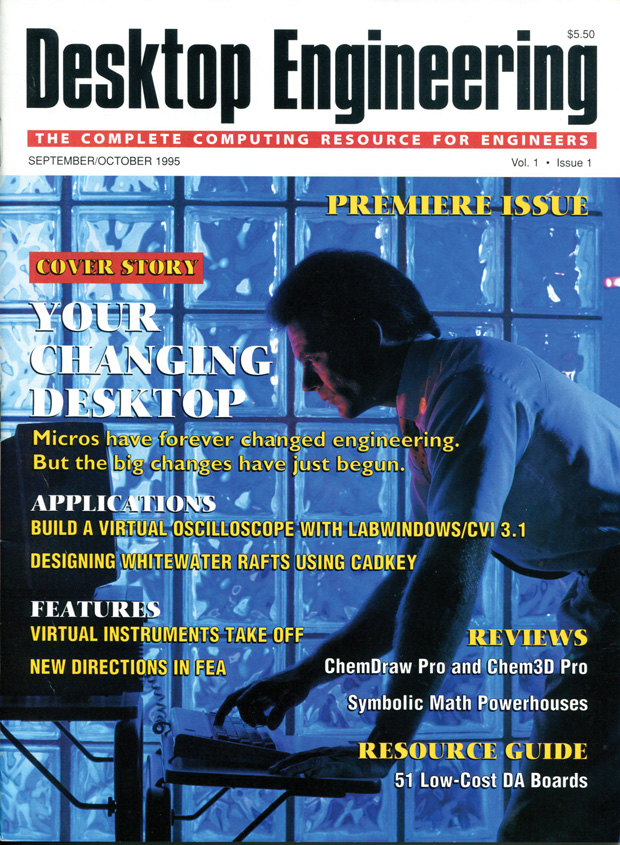Latest News
September 1, 2016
 This is an anniversary issue for DE, so the editors asked me—DE’s founding editor and silverback—to bloviate about what the future holds in store for design engineering hardware and software.
This is an anniversary issue for DE, so the editors asked me—DE’s founding editor and silverback—to bloviate about what the future holds in store for design engineering hardware and software.
Well, it beats me; although I bet it’ll be amazing.
But I can tell you that, over two decades ago, the cover story of the first-ever issue of Desktop Engineering was “Your Changing Desktop.” Its deck was “Micros have forever changed engineering. But the big changes have just begun.”
“Micros” is a bit quaint these days. Yet its meaning remains strong. It’s the disruptive technology that made it possible for you to leverage the engineer’s toolkit to create and manipulate designs, data sets and simulations unimaginable by millennia of engineers who preceded you.
In that first cover story, DE editors (um, I, he modestly admits) solicited the thoughts from some of the day’s leading hardware and software innovators about the future of the design engineer’s toolset. The give and take was all handled through email—a way-phat approach back then.
They spoke of emerging and far-fetched technologies residing on or reaching out from your desktop computer that became this century’s norm: 3D solid modeling, FEA (finite element analysis) and CFD (computational fluid dynamics) simulations with millions of elements, PCs as instrumentation platforms that rivaled benchtop units and that you could graphically (!) reprogram to meet new challenges, collaborative engineering, the internet bringing new communications habits, digital workflows where heterogeneous applications seamlessly share data and more.
And they were mostly right. See, we all missed one thing: Our changing desktop.
The Medium is the Workstation
Really, what’s your desktop today? Is it (sorry Tom Wolfe) a multi-GB kandy-kolored tangerine-flake streamlined baby tricked out with tons of storage and what’s really an embedded computer crunching numbers and producing astonishing 3D graphics? Maybe it’s a thin client wired to your company’s HPC (high-performance computing) system. Is your desktop a notebook with more brawn and snazzier graphics than the big iron, “real” computers of yore? Do you use it to link up over the internet to a software on-demand service? Or is your desktop a tablet or smartphone with apps wirelessly tethering you to the head office’s systems and software so that you can work productively and securely from a table at a beachside bar in Maui?
Odds are your desktop is already—or will soon be—all of the above. And that means your desktop no longer exists as the only medium enabling your engineering toolkit. It’s been assimilated into a construct that incorporates many vital components: workstations, thin clients, smartphones, tablets and software. They’re all linked through networks and the internet into a digital engineering workflow that pushes boundaries and constraints further out. Your desktop now is whatever medium you use to access and interact with your digital data at a given moment.
Subtly over time, this structural change revolutionized engineering software and workflows. This transmogrification means you need to understand, manage and exploit the design engineer’s digital workflow and all its hardware and software in new ways. To focus on the desktop-confined workflow misses the forest for a tree. We’re beyond that era.
Spare Some Change
When DE’s honchos asked me to scribble this diatribe, they said—warily for I’m cranky—that they were changing the “D” in DE from “Desktop” to “Digital” as in Digital Engineering. I said: “Go for it.”
You see, that first cover article used three simple words—your changing desktop—to plant a flag and a seed. The flag meant that DE would provide you the news and information about the latest engineering technologies that you need to succeed in your career and business ventures. The seed was the promise that DE would evolve alongside your evolving design engineering workflow.
Where’s that workflow going tomorrow? Beats me. But I know that the big changes have just begun and that DE will be there with you for the ride.
Thanks, Pal.—Lockwood
Subscribe to our FREE magazine, FREE email newsletters or both!
Latest News
About the Author
Anthony J. Lockwood is Digital Engineering’s founding editor. He is now retired. Contact him via [email protected].
Follow DE






